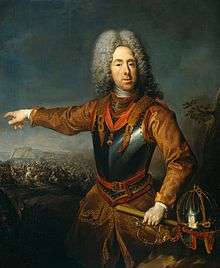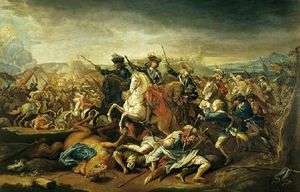Prinz Eugen, der edle Ritter
"Prinz Eugen, der edle Ritter" (Prince Eugene, the Noble Knight) is an Austrian-German folksong about the victory of Prince Eugene of Savoy in 1717 during the Austro-Turkish War of 1716–1718.



Theme
The song is a narrative of the Siege of Belgrade (1717). The text diverts from historical accuracy in two aspects. The day of the final assault on the defenders is given as the 21 August although it was 16 August. Second, the song tells of the death of one a Prince Louis (Prinz Ludewig). Eugene had two brothers named Louis but none of them fell at Belgrade. The younger one, Louis Julius (1660–1683) who had entered Imperial service prior to Eugene was killed by Crimean Tatars at Petronell, whereas the older one, Louis Thomas (1657–1702) had died at the Siege of Landau (1702).
Background and legacy
The author of the song is unknown. The melody derives from "Als Chursachsen das vernommen" (1683) and has also been adopted in the period before the German revolutions of 1848–49 to "Ob wir rote, gelbe Kragen" (Whether we [wear] red or yellow collars). Josef Strauss composed in 1865 his Prinz Eugen March, Op. 186, for the unveiling of a statue of Prince Eugene at the Heldenplatz in Vienna; it uses elements of the folksong.
Lyrics
Prinz Eugen der edle Ritter, |
Prince Eugene, the noble knight, |
External links
- Notes and text
- Lyrics in German and Latin, ingeb.org
- Lyrics and history in German and English, Jean-Louis Vial
- A more poetic translation